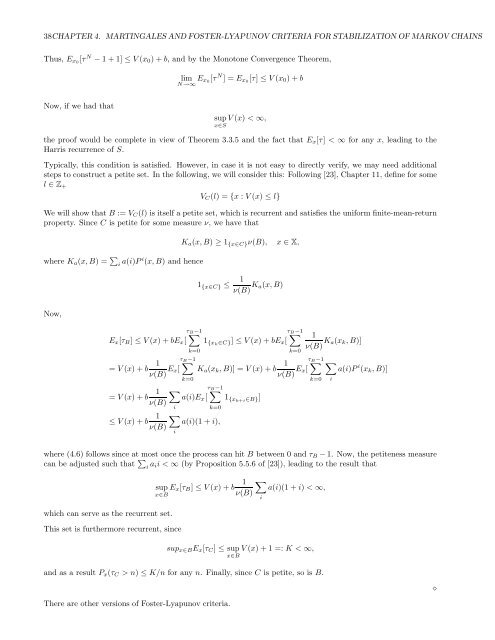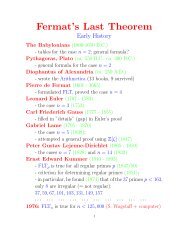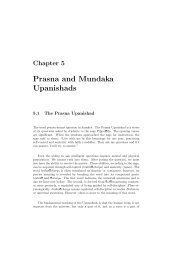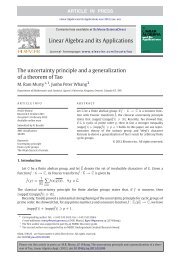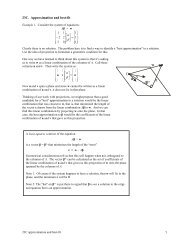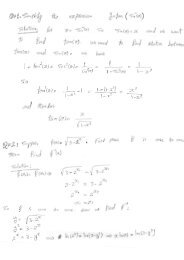Lecture Notes - Department of Mathematics and Statistics - Queen's ...
Lecture Notes - Department of Mathematics and Statistics - Queen's ...
Lecture Notes - Department of Mathematics and Statistics - Queen's ...
You also want an ePaper? Increase the reach of your titles
YUMPU automatically turns print PDFs into web optimized ePapers that Google loves.
38CHAPTER 4. MARTINGALES AND FOSTER-LYAPUNOV CRITERIA FOR STABILIZATION OF MARKOV CHAINS<br />
Thus, E x0 [τ N − 1 + 1] ≤ V (x 0 ) + b, <strong>and</strong> by the Monotone Convergence Theorem,<br />
lim<br />
N→∞ E x 0<br />
[τ N ] = E x0 [τ] ≤ V (x 0 ) + b<br />
Now, if we had that<br />
sup V (x) < ∞,<br />
x∈S<br />
the pro<strong>of</strong> would be complete in view <strong>of</strong> Theorem 3.3.5 <strong>and</strong> the fact that E x [τ] < ∞ for any x, leading to the<br />
Harris recurrence <strong>of</strong> S.<br />
Typically, this condition is satisfied. However, in case it is not easy to directly verify, we may need additional<br />
steps to construct a petite set. In the following, we will consider this: Following [23], Chapter 11, define for some<br />
l ∈ Z +<br />
V C (l) = {x : V (x) ≤ l}<br />
We will show that B := V C (l) is itself a petite set, which is recurrent <strong>and</strong> satisfies the uniform finite-mean-return<br />
property. Since C is petite for some measure ν, we have that<br />
where K a (x, B) = ∑ i a(i)P i (x, B) <strong>and</strong> hence<br />
K a (x, B) ≥ 1 {x∈C} ν(B), x ∈ X,<br />
1 {x∈C} ≤ 1<br />
ν(B) K a(x, B)<br />
Now,<br />
τ∑<br />
B−1<br />
E x [τ B ] ≤ V (x) + bE x [<br />
1<br />
= V (x) + b<br />
ν(B) E x[<br />
k=0<br />
τ∑<br />
B−1<br />
k=0<br />
1 ∑<br />
τ∑<br />
B−1<br />
= V (x) + b a(i)E x [<br />
ν(B)<br />
i k=0<br />
1 ∑<br />
≤ V (x) + b a(i)(1 + i),<br />
ν(B)<br />
i<br />
τ∑<br />
B−1<br />
1 {xk ∈C}] ≤ V (x) + bE x [<br />
k=0<br />
1<br />
K a (x k , B)] = V (x) + b<br />
ν(B) E x[<br />
1 {xk+i ∈B}]<br />
1<br />
ν(B) K a(x k , B)]<br />
τ∑<br />
B−1<br />
k=0<br />
∑<br />
a(i)P i (x k , B)]<br />
i<br />
where (4.6) follows since at most once the process can hit B between 0 <strong>and</strong> τ B − 1. Now, the petiteness measure<br />
can be adjusted such that ∑ i a ii < ∞ (by Proposition 5.5.6 <strong>of</strong> [23]), leading to the result that<br />
sup<br />
x∈B<br />
which can serve as the recurrent set.<br />
This set is furthermore recurrent, since<br />
1 ∑<br />
E x [τ B ] ≤ V (x) + b a(i)(1 + i) < ∞,<br />
ν(B)<br />
sup x∈B E x [τ C ] ≤ sup V (x) + 1 =: K < ∞,<br />
x∈B<br />
<strong>and</strong> as a result P x (τ C > n) ≤ K/n for any n. Finally, since C is petite, so is B.<br />
There are other versions <strong>of</strong> Foster-Lyapunov criteria.<br />
i<br />
⋄


